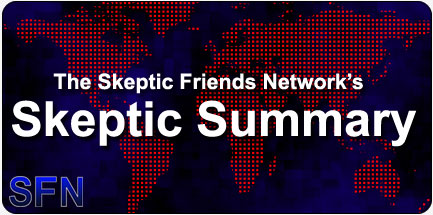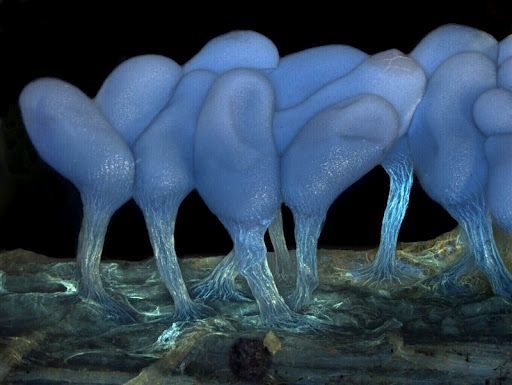|
|
|

Skeptic Summary #376
By The Staff
Posted on: 11/18/2012
|
Darth Goofy, lasers, turbines, sore losers, the Secret, Thanksgiving, Olympus Bioscapes and more!
|
Week ending November 18, 2012 (Vol 9, #25)
Welcome to the Skeptic Summary, a quick, bi-weekly review of the Skeptic Friends Network and the rest of the skeptical world.
This issue of The Skeptic Friends Network Skeptic Summary is dedicated to the memory of Paul Kurtz. His contributions to the rise of the skeptical and freethinking movements, and his promotion of secularism and humanism are in a very large part the foundation that all of today’s freethinking movements are built upon.

Forum Highlights:Election 2012 - SFN discusses the US elections before, during, and after.
Disney buys Lucasfilm… more Star Wars movies coming - With Mickey as Emperor?
Laser therapy (photo-bio-modulation) - Pseudo-scientific medicine for pets.
Wind turbines sound causes depression? - Inrasound is a problem, but more study is required.
Editor’s Choice: Talk about your sore losers! - Sour grapes abound, post-election.
From the Archives: The Secret - The movie about how wishing can come true, if you wish hard enough.

This Week’s Poll:Thanksgiving - Whatcha gonna do?

Kil’s Evil Pick:Olympus BioScapes International Digital Imaging Competition Website — I love cool strange photos of the science kind. Videos too. And of those kinds of images, my favorites are of the microscopic variety, where we find all kinds of surprises, and telescopic starscapes of the Hubble kind, where we find more suprises. You know, like the most important photo ever taken. And how about those nebulae?

But for now, let’s concern ourselves with the very small. Better yet, the small and living. Olympus BioScapes are photos and videos of microscopic images taken of living inner-space systems and microscopic organisms. And as the name, Olympus BioScapes International Digital Imaging Competition more than implies, it’s a contest. A very cool contest! Why? Well for our purposes, it’s because they have the Winners Gallery posted for every year since 2004, and each gallery includes Honorable Mentions and a Technical Merit Award. I’m talking about a whole bunch of stunning photos and videos!

A section of a rat cerebellum taken
by Thomas Deernick (University of California)
for the 2010 competition
Here’s a bit of what they say about themselves:Welcome to the Olympus BioScapes International Digital Imaging Competition Website
Congratulations to the winners of the 2012 Olympus BioScapes Digital Imaging Competition! Come back December 17, 2012 (9am US East Coast time) to view this year’s winning images and movies.
…
“Microscope images forge an extraordinary bond between science and art,” said Hidenao Tsuchiya, Olympus America’s Vice President and General Manager for the Scientific Equipment Group. “We founded this competition to focus on the fascinating stories coming out of today’s life science research laboratories. The thousands of images that people have shared with the competition over the years reflect some of the most exciting work going on in research today — work that can help shed light on the living universe and ultimately save lives. We look at BioScapes and these beautiful images as sources of education and inspiration to us and the world.”
The Olympus BioScapes Digital Imaging Competition® recognizes outstanding images of life science specimens captured through light microscopes, using any magnification, any illumination technique and any brand of equipment. Each person entering can submit up to five movies, images, or image sequences (such as time lapse series). Entries must include information on the importance or “story” behind the images… Selected winning images also become part of a traveling exhibit tour of museums and academic institutions.

This is a rotifer, a microscopic aquatic animal,
feeding on nutrients in the water around it. The image was
taken by Charles Krebs of Issaquah, Washington.
They point out in the rules area that the judges are not told what kind of camera was used. So if you use a Nikon, you can still win. Not that I expect the readers here to enter. But you can. You can also check for Museum Tour dates. The gallery just might be coming to a museum near you!

Young sporangia of slime mold. Image taken by
Dr. Dalibor Matýsek, Mining University — Technical University
of Ostrava Ostrava, Czech Republic
So on to the Olympus BioScapes International Digital Imaging Competition Website and be once again reminded of how visually mind-blowing the natural world is.
SkeptiQuote:The good thing about science is that it's true whether or not you believe in it. — Neil deGrasse Tyson |

Chat Highlights:Wednesdays: We had two chats since the last summary. They were fun. We will have one next Wednesday evening. It will be fun. We will also have one the following Wednesday night too. That’s what we do on Wednesday nights. We do chat…
Come chat with us. 
New Members This Week:pennster
granbo
Christian
opsarch
Laaranya
minass
Sherif Laoun
(Not a member? Become one today!)

Elsewhere in the World:10 Questions To Distinguish Real From Fake Science
100,000 Stars
Argumentum ad Monsantium
Be persuasive. Be brave. Be arrested (if necessary)
Bladeless Wind Turbine Inspired by Sails
Bride of Frankenstorm
Clowns face off with KKK
Communicating through MRI? How do they know what he is saying?
Doubtful News
Evolution of lactose tolerance: Why do humans keep drinking milk?
Is Caputo Kaputo Yet?
‘Island of the Blue Dolphins’ woman’s cave believed found
Journal of Universal Rejection
Psychics fail tests of their abilities in academic setting
The psychopath detector
Skepticality #195 — Fake Science 101
Stanislaw Burzynski and the Antineoplaston Scam
Top Georgia GOP Lawmakers Host Briefing on Secret Obama Mind-Control Plot
We get revenge: the FFRF sues the IRS for failure to enforce tax laws on churches
What’s New by Bob Park
World War II Carrier Pigeon With Coded Message Found In England
Your grade for science: N/A
Got some skeptic news items? Send them to us, and we’ll think about adding them.

Book of the Week:The Last Myth: What the Rise of Apocalyptic Thinking Tells Us About America, by Mathew Barrett Gross and Mel Gilles.

“During the first dozen years of the twenty-first century — from Y2K through 2012 — apocalyptic anticipation in America has leapt from the margins of society and into the mainstream. Today, nearly 60 percent of Americans believe that the events foretold in the book of Revelation will come true. But it’s not just the Christian Right that is obsessed with the end of the world; secular readers hungry for catastrophe have propelled fiction and nonfiction books about peak oil, global warming, and the end of civilization into best-sellers, while Doomsday Preppers has become one of the most talked-about new reality TV shows on television. How did we come to live in a culture obsessed by the belief that the end is nearly here?
The Last Myth explains why apocalyptic beliefs are surging within the American mainstream today. Tracing the development of our expectation of the end of the world from the beginnings of history through the modern era, and examining the global challenges facing America today, authors Mathew Barrett Gross and Mel Gilles combine history, current events, and psychological and cultural analysis to reveal the profound influence of apocalyptic thinking on America’s past, present, and future.
Engaging, powerful, and insightful, The Last Myth will change the way you look at the world — and its end.”
— Book Description

This Week’s Most-Viewed Pages:Forum Topics:- Stan Lee’s superhumans
- Dr. Jeffery Life and Cenegenics
- Talk about your sore losers!
- Little-a versus big-A atheism
- Random fun
- Scattershots: gargoyles & grotesques
- The Supper
- Obama supporters suffering delusional disorder
- The Skeptic Summary
- Funny FAILS
Articles:- Evolving a Venom or Two
- Miracle Thaw — The Bogus Miracle
- Fundamentalists Hate Noah’s Ark
- Is the Speed of Light Slowing Down?
- What is a Skeptic and Why Bother Being One?
- Free the Glutens, or When a Cookie isn’t Just a Cookie
- Cold Reading
- Skeptic Summary #371
- The Legend of the Shrinking Sun
- Preaching that Anti-Evolution Propaganda
There were 6,694 daily visitors this week.
More issues of the Skeptic Summary can be found in our archive.
The Skeptic Summary is produced by the staff of the Skeptic Friends Network, copyright 2012, all rights reserved.
Read or Add Comments about the Skeptic Summary
|
|
|
Back to Skeptic Summary
|
![]()